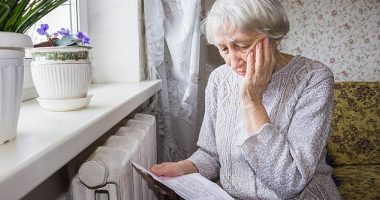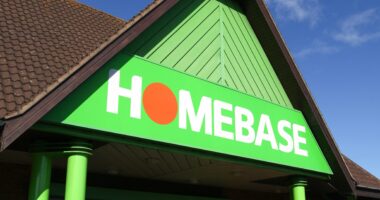GETTING onto the property ladder can seem like a daunting task but shared ownership schemes can give you the leg up you need.
They help with lower upfront costs that allow you to gradually build up how much of the property you own.
You rent a portion of the property from a housing association and get a shared ownership mortgage to pay for the rest.
But it is a little more complicated than that, so we explain how it all works.
What is a shared ownership scheme?
Shared ownership lets first-time buyers purchase a portion of the equity in a property if they can’t afford to take out a mortgage for the total value of the home.


It is also known as part-buy, part-rent.
You’ll co-own your home with a housing association, often a new-build, which will charge you rent on its portion of the property.
(AD) Understand your mortgage options by visiting Compare the Market.
Buyers must purchase between 10% and 75% of the property to use the initiative, and they can then “staircase” – buy more shares in instalments – until they own 100% of it.
Most read in Money
You can fund your share using a shared ownership mortgage.
What is a shared ownership mortgage?
A shared ownership mortgage lets you buy a share of a property under the housing scheme.
Like a normal mortgage, you will need a deposit.
For example, if you want to buy a 25% share of a £300,000 property using shared ownership you would need a £75,000 mortgage.
If you had a 10% deposit, you would need to put down £7,500 and borrow £67,500.
The housing association you are buying through stumps up the remaining £225,000.
(AD) Understand your mortgage options by visiting Compare the Market.
How does a shared ownership mortgage work?
Similar to a standard mortgage, there will be an interest rate to pay and you will need to put down a deposit, usually of around 5% or 10%.
This means a bank or building society may lend up to 95% loan-to-value for a shared ownership mortgage.
You will need to pass a lenders affordability and interest rate stress tests that assess your income and expenditure and what you can afford if the mortgage costs go up.
There will be monthly repayments for your mortgage, and you will also have to pay rent to the housing association until you fully own the property.
The rent is decided by the housing association but is usually below the market rate and around 3% of its share.
So if you buy 25% of a £300,000 property through a housing association, you need to pay monthly rent for the remaining 75% or £225,000.
This works out as £6,750 per year based on a 3% charge or £562.50 per month.
(AD) Understand your mortgage options by visiting Compare the Market.
Who qualifies for shared ownership?
You can use the shared ownership scheme as long as your household earns £80,000 a year or less, rising to £90,000 in London.
You must be a first-time buyer or have sold your home and be unable to afford a new one.
It is also open to existing shared owners.
There is an older people’s shared ownership scheme aimed at those aged 55 or over to buy up to 75% of a home.
Plus disabled people can access a scheme called home ownership for peeople with a long term disability.
Contact your local Help to Buy agent to see which schemes you are eligible for in England and your local authority in Wales.
There is also a low cost shared equity scheme in Scotland and a co-ownership initiative in Northern Ireland.
(AD) Understand your mortgage options by visiting Compare the Market.
How do I apply for a shared ownership scheme?
You can find local shared ownership properties on the Share to Buy website, or contact your local housing association.
A housing association will conduct a financial assessment to ensure you meet the income criteria and see what size share you can afford, as well as whether you can manage the monthly rent.
The Share to Buy website also has a useful shared ownership mortgage calculator that gives an indication of what you can afford based on your income and expenses.
(AD) Understand your mortgage options by visiting Compare the Market.
What banks offer shared ownership mortgages?
There is limited choice of shared ownership mortgages, which can make it hard to find the best deal.
Some of the mainstream lenders do offer shared ownership mortgages and suggest working with a broker to get the right deal.
(AD) Understand your mortgage options by visiting Compare the Market.
How do I apply for a shared ownership mortgage?
If eligible for the scheme, you will need to get a shared ownership mortgage.
There are a limited number of lenders providing shared ownership mortgages but the application process is the same.
You will need to prove your ID and show evidence of your income and expenses.
This usually involves three months of bank statements as well as payslips.
A lender will do a credit check and an affordability assessment to see if you can meet the loan repayments, and also an interest rate stress test that looks at how your finances would cope if the mortgage costs increased.
A broker may also be able to help find the best shared ownership mortgage from lenders and prepare your application.
The value of the mortgage is based on the share of the property you are buying rather than the full value so may be lower than if you were buying a standard home.
(AD) Understand your mortgage options by visiting Compare the Market.
How much deposit do I need for a shared ownership mortgage?
Lenders set their own deposits based on the loan-to-value (LTV) they are happy to provide and what your property is worth.
Deposits range from 5% to 25%.
So if a lender has a 90% LTV shared ownership mortgage, your deposit would be 10% of your share of the property you are buying.
(AD) Understand your mortgage options by visiting Compare the Market.
What are the advantages of shared ownership mortgages?
A shared ownership mortgage can provide a more affordable way of getting on the property ladder.
You typically need a lower mortgage of between 5% and 10% so the upfront costs are reduced.
It may be cheaper than renting as you pay rent below market rate to the housing association.
You can also slowly build up full ownership of your property by making “staircasing” payments.
This helps you buy more of your property when you can afford to do so.
(AD) Understand your mortgage options by visiting Compare the Market.
What are the disadvantages of shared ownership mortgages?
One of the issues with shared ownership is that you don’t have as much freedom when it comes to selling your home, compared to if you hadn’t used the scheme.
If you own less than 100%, your housing association will get a set period of time to find a buyer, meaning you won’t be able to accept a higher offer from someone else.
Many shared ownership leases also contain a clause that gives the housing association dibs on buying it back before offering it on the market.
There are also fewer lenders offering shared ownership mortgages compared with standard ones.
This means there isn’t much competition to offer decent rates.
Another issue is that shared ownership mortgages are usually leasehold.
There will be service charges to pay and there could be restrictions on renovations or having pets.
Like any mortgage, your home is at risk of being repossessed if you fail to keep up with repayments.
You won’t be able to rent out the property either.
(AD) Understand your mortgage options by visiting Compare the Market.
Can I buy a larger share of my home at a later date?
You can build up your share of the property to 100% using a process called staircasing.
This lets you make small payments based on a percentage of the value of the property until you get to 100%.
There is no requirement to do this but it can make the property easier to sell if you own all of it.
You can make staircasing payments in instalments of as little as 1% of the property’s value, but there may be limits in your lease on how many times you can do it.
For example, if you wanted to buy an additional 10% share of a £300,000 property, you would need to pay £30,000.
It’s worth bearing in mind that the portion you buy is worth a percentage of the property’s value at the time, so you’ll pay more if house prices go up.
But it also means you’ll pay less if house prices fall.
You will have to pay legal and valuation fees as well as stamp duty tax – if applicable – every time you staircase, which could end up costing you more in the long run.
We previously spoke to a first-time buyer who ended up paying the tax three times after purchasing her shared ownership flat.
(AD) Understand your mortgage options by visiting Compare the Market.
Is shared ownership the same as a shared equity scheme?
Shared ownership is different to a shared equity scheme.
You don’t own the full property under shared ownership unless you staircase to 100%.
However, a shared equity scheme such as Help to Buy gives you ownership of the property.
This is because you are given help with an equity loan that counts towards your deposit so you can get a mortgage to buy your home.
(AD) Understand your mortgage options by visiting Compare the Market.
Can I get a shared ownership mortgage with bad credit
A lender will do a credit check when you apply for a shared ownership mortgage.
It can be harder to get any sort of loan when you have bad credit.
This means if you have a history of missed debt repayments, county court judgements or bankruptcies, it could be harder to get approved for a shared ownership mortgage.
Additionally, a housing association may do a credit check to assess your ability to pay the rental portion of your property.
Bad marks can stay on your credit file for six years, but you can boost your score by clearing old debts or signing up to a credit builder card.
It may be worth waiting until your credit rating is higher before applying especially as successive rejected applications can harm your score further.
(AD) Understand your mortgage options by visiting Compare the Market.
How does stamp duty work?
There are a couple of options with stamp duty payments.
If you purchase a shared ownership property above the stamp duty threshold, you can make a one-off payment of the tax based on the whole value of the property.
Alternatively, you can pay in stages based on the value of your share and each time you buy more.
This can end up costing you more though depending on the value of the property each time you increase your share.
(AD) Understand your mortgage options by visiting Compare the Market.
How much do shared ownership mortgages cost?
Shared ownership mortgage rates will vary across different lenders.
The rate you pay will depend on the value of the loan and how long you are borrowing for.
The rates will usually be lower if you put down a larger deposit, which will mean smaller monthly repayments.
There may also be product fees to pay.
(AD) Understand your mortgage options by visiting Compare the Market.
Are there any other fees?
Beyond any mortgage arrangement fees, you may also have to pay for property valuations and the legal conveyancing process to complete the purchase.
There may also be stamp duty to pay.
Additionally, you may have to pay valuation fees and stamp duty each time you increase your share.
(AD) Understand your mortgage options by visiting Compare the Market.
Can I make home improvements?
Any home improvements or major refurbishments have to be run by the housing association as it may not be allowed in the lease.
In most cases a housing association should grant permission for changes such as a new kitchen as it will also benefit from any increase in the value of the property as a result of the changes.
(AD) Understand your mortgage options by visiting Compare the Market.
How do I sell my home?
Selling a shared ownership property is slightly different to the normal sales process.
If you own less than 100% you need to give the housing association a period of time to find a buyer, and they can value the property as they wish.
They must be given eight weeks to find someone who will buy your share, but owners are able to opt-out of this period after four weeks and try to sell on the open market.
Once sold, you will receive a share of the proceeds depending on how much you own.
If you own 100% of the property you can sell it yourself without any restrictions.
(AD) Understand your mortgage options by visiting Compare the Market.
What happens if the value of my house changes?
You will benefit from any increase in the property value when you sell as there will be more profits to share between you and the housing association depending how much you own.
However, if the value has dropped you may end up having to sell at a loss.
The value of the property is also important when you are increasing your share.
You will pay more for a percentage if the value has gone up and less if it has gone down.
(AD) How to find the best mortgage for your needs
YOUR mortgage is one of the most significant investments you’ll make in your lifetime; and it pays to shop around.
What are the alternatives to shared ownership mortgages?
A shared ownership mortgage is just one affordable housing scheme to help buyers onto the property ladder.
Help to Buy equity loan: The government will lend you up to 20% of the value of a new-build home – or 40% in London – after you’ve put down a 5% deposit.
The loan is on top of a normal mortgage, but it can only be used to buy a new build property in England and is subject to regional house price caps.
Lifetime Isa: This is another government scheme that gives anyone aged 18 to 39 the chance to save tax-free and get a bonus of up to £32,000 towards their first home. You can save up to £4,000 a year and the Government will add 25% on top.
Right to Buy: Helps council or housing association tenants purchase their home at a discount of up to £84,600 in England, £112,800 in London and £24,000 in Northern Ireland.
(AD) Understand your mortgage options by visiting Compare the Market.


Read More
Important Information
News Group Newspapers Ltd is an Introducer Appointed Representative of Compare The Market Limited, which is authorised and regulated by the Financial Conduct Authority (FRN 778488). Compare The Market Limited, registered in England and Wales No. 10636682. Registered Office: Pegasus House, Bakewell Road, Orton Southgate, Peterborough, PE2 6YS.
We pay for your stories!
Do you have a story for The Sun Online Money team?









